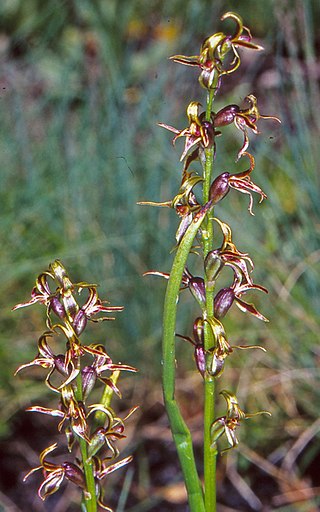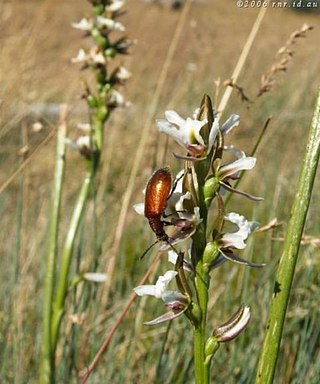Prasophyllum australe, commonly known as the southern leek orchid or austral leek orchid, is a species of orchid and is endemic to south-eastern Australia. It has a single tubular, green leaf and up to fifty scented, greenish-brown flowers with red stripes.

Prasophyllum brevilabre, commonly known as the short-lip leek orchid, is a species of orchid endemic to south-eastern Australia. It has a single tubular, green leaf and up to thirty small, greenish-brown flowers with a white labellum. The labellum is sharply turned back on itself so that its tip almost reaches its base.

Prasophyllum sphacelatum, commonly known as the subalpine leek orchid, is a species of orchid endemic to south-eastern Australia. It has a single tubular, dull green leaf and up to eighteen scented, green to brownish flowers with a green to pinkish labellum. It grows in subalpine areas of New South Wales, Victoria and Tasmania.
Prasophyllum campestre, commonly known as the sandplain leek orchid, or inland leek orchid, is a species of orchid endemic to eastern Australia. It has a single tubular, yellowish-green leaf and up to twenty greenish, strongly scented flowers with red, purplish, brown or white marks. It grows in the drier parts of Queensland, New South Wales and Victoria.

Prasophyllum sylvestre, commonly known as the forest leek orchid, is a species of orchid endemic to south-eastern Australia. It has a single tubular, bright green leaf and up to thirty faintly scented, pale green, pink and reddish-brown flowers. It is similar to P. fuscum and P. affine but differs from them, including in the habitat in which they grow.

Prasophyllum odoratum, commonly known as the fragrant leek orchid, Rogers scented leek orchid or sweet leek orchid is a species of orchid endemic to south-eastern Australia. It has a single tubular leaf and up to fifty fragrant green and white flowers with reddish marks.
Prasophyllum barnettii, commonly known as the Anglesea leek orchid, is a species of orchid endemic to Victoria. It has a single tubular leaf and between twelve and thirty scented yellowish, reddish or brownish flowers and is only known from a small area in the south of the state.
Prasophyllum calcicola, commonly known as the limestone leek orchid, is a species of orchid endemic to Australia. It has a single, smooth, tube-shaped leaf and up to twelve yellowish-green flowers on an erect flowering stem. It is found in coastal areas of Western Australia and South Australia growing on soils derived from limestone.
Prasophyllum candidum, commonly known as the Kiandra leek orchid, is a species of orchid endemic to eastern Australia. It has a single tubular, yellowish-green leaf and up to forty scented, bright white to greenish flowers. It grows in subalpine areas at altitudes above 1,000 m (3,000 ft) in New South Wales and Victoria although in the latter state it is considered to be a form of P. odoratum.

Prasophyllum caudiculum, commonly known as the Guyra leek orchid, is a species of orchid endemic to a small area of northern New South Wales. It has a single tubular, bright green leaf and up to thirty five greenish to reddish-brown flowers crowded along an erect flowering stem. It grows in grassy places near Guyra.

Prasophyllum colensoi is a species of orchid endemic to New Zealand where it is commonly known as the leek orchid. It has a single tubular, dark green leaf and up to twenty scented, yellowish-green to reddish-brown flowers. It is similar to P. hectori, the only other species of Prasophyllum found in New Zealand, but is distinguished from it by its smaller size, fewer flowers and different habitat.
Prasophyllum fosteri, commonly known as the Shelford leek orchid, is a species of orchid endemic to a small region of Victoria. It has a single tubular green leaf and up to twenty five green to reddish-brown flowers. It is a very rare orchid, only known from a single population on a roadside.
Prasophyllum occultans, commonly known as the hidden leek orchid, is a species of orchid endemic to southern Australia. It has a single, smooth, tube-shaped leaf with a reddish-purple base and up to ten greenish flowers. It is a rare species found only in a few locations in South Australia and in far western Victoria.

Prasophyllum patens, commonly known as the broad-lipped leek orchid or sandstone leek orchid, is a species of orchid endemic to the Sydney region of New South Wales. It has a single tubular green leaf and up to thirty green to greenish-brown, lemon-scented flowers with a white labellum.
Prasophyllum retroflexum, commonly known as the congested leek orchid or Kiandra leek orchid, is a species of orchid endemic to a small area near the border between New South Wales and Victoria, growing in subalpine herbfields. It has a single tubular leaf and up to forty densely-crowded, pale green flowers with pinkish markings.
Prasophyllum rogersii, commonly known as the Barrington Tops leek orchid is a species of orchid endemic to New South Wales. It has a single tubular leaf and up to twenty five reddish-brown flowers and only occurs in a few locations at higher altitudes.

Prasophyllum suttonii, commonly known as the mauve leek orchid, Mount Buffalo leek orchid or Buffalo leek-orchid, is a species of orchid endemic to the Australian Alps. Some authorities list the species as being a Victorian endemic now extinct whilst others list is as occurring in New South Wales and extant. Descriptions of the species also differ. It has a single tube-shaped leaf and up to thirty five white flowers with purple or mauve marks.
Prasophyllum uvidulum, commonly known as the summer leek orchid, is a species of orchid endemic to Victoria. It has a single, tubular leaf and up to twenty five scented, pale green flowers with reddish markings and is only known from a swamp in the north-east of the state.
Prasophyllum fitzgeraldii, commonly known as FitzGerald's leek orchid, is a species of orchid endemic to South Australia. It has a single tube-shaped leaf and up to thirty five green or reddish-brown flowers with a pink to purple labellum. It was previously thought to also occur in Victoria.
Prasophyllum roseum, commonly known as the pink lip leek orchid, is a species of orchid endemic to southern continental Australia. It has a single tube-shaped leaf and up to thirty greenish flowers with a pink labellum. It is a recently described plant, previously included with P. fitzgeraldii, but distinguished from that species by its smaller, less crowded flowers, with more spreading lateral sepals and different labellum callus. It grows in the south-east of South Australia and in western Victoria.







